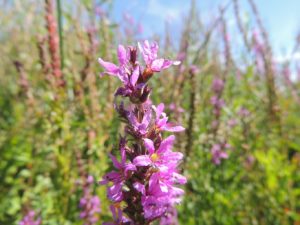Galerucella spp.
- Common Name: Black-margined loosestrife beetle (Galerucella calmariensis)
- Common Name: Golden loosestrife beetle (Galerucella pusilla)
- Insect: Beetle, (Coleoptera: Chrysomelidae)
- Generations Per Year: One
- Overwintering Stage: Adult (in soil)
BIOLOGY: Adults emerge from soil in April and June. Adults are 3-5 mm long and orange with brown stripes along the wings. Eggs are laid from May–September on stems and leaves in clusters of 3-6. Females produce up to 400 eggs. Eggs hatch in 12 days. Larvae feed on buds and leaves for 14 days. Larvae are small (3-4mm) and light green with brown to black spots. Pupation takes 7 days and occurs in the soil or in the spongy tissue of stems in standing water.
DESTRUCTIVE STAGE: Adults and larvae (feeding on buds and leaves)
IMPACT TO HOST: Adult and larval feeding results in stunted plants and reduced seed production. In some areas of Utah, complete control of purple loosestrife has been attributed entirely to biological control.
REDISTRIBUTION: Adults can be collected in sweep nets or by picking adults off of plants. A typical release is 250 adults. Collection is best in late April or early May. Adults overwinter in the ground so continuously flooded areas are not ideal for release. Also, beetles are very susceptible to insecticides used for mosquito abatement. If sprayed, most beetles will die.


